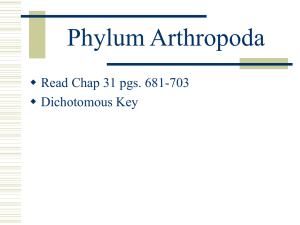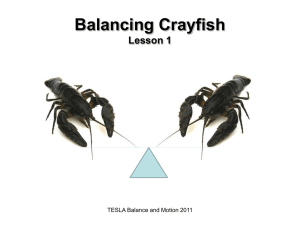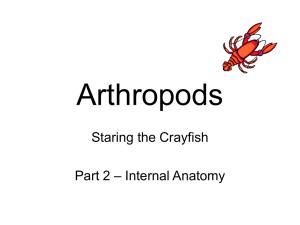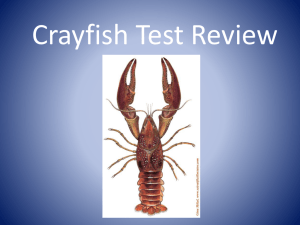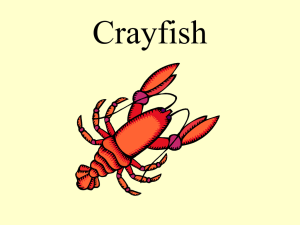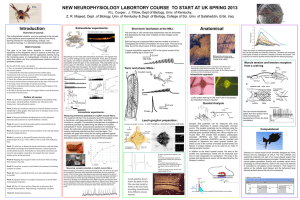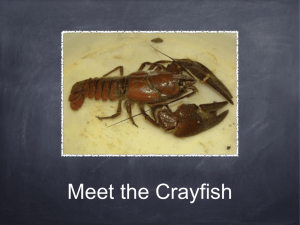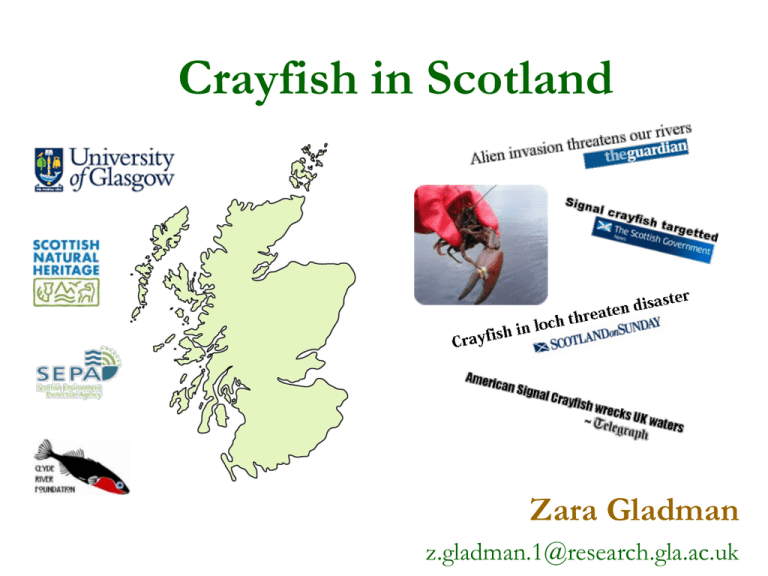
Crayfish in Scotland
Zara Gladman
z.gladman.1@research.gla.ac.uk
Overview
Crayfish in Scotland
North American signal crayfish
White-clawed crayfish
Research so far: a synopsis
What next?
Crayfish in Scotland
Crayfish are naturally absent from
Scotland
Two introduced species:
White-clawed crayfish
(Austropotamobius pallipes)
North American signal crayfish
(Pacifastacus leniusculus)
Crayfish in Scotland
Signal crayfish (Pacifastacus leniusculus)
First recorded in the wild in Galloway, southern Scotland in
1995
Now inhabits ~ 174 km river length (13 catchments) and
several standing waters
Serious threat to biodiversity – pressing need for research
‘Species Action Framework’, 2007
Crayfish in Scotland
White-clawed crayfish (Austropotamobius pallipes)
Native to Europe, including England, Wales and Ireland
– but not Scotland
Two Scottish populations
Non-native but protected species (Schedule 5 of Wildlife &
Countryside Act 1981, Appendix III of Bern Convention, Annexes IIa and Va of
EC Habitats Directive and the Nature Conservation (Scotland) Act 2004, IUCN
Red List of Threatened Species)
Research so far . . .
1. White-clawed crayfish
Status of Scottish populations
2. Signal crayfish
Distribution
Movements (radiotracking)
Control (trapping at Loch Ken)
Impact
1. White-clawed crayfish
Two introduced populations
Durness (Thomas, 1992)
Renfrewshire (Maitland, 2001)
Aim: survey both sites to assess the status of
these populations
Surveys
Trapping
Hand-searching
Night viewing
Electrofishing
Invertebrate sampling
Surveys
Providing data on:
Distribution
Population structure
Relative density
Stable isotope samples
Research so far . . .
1. White-clawed crayfish
Status of Scottish populations
2. Signal crayfish
Distribution
Movements
Control
Impact
2. Signal crayfish
Distribution
Methods for detecting signal crayfish in riffles – comparative field study
Gladman et al. (2010), Aquatic Conserv: Mar. Freshw. Ecosyst. 20: 588-594
2. Signal crayfish
Movements
Radio-tracking, mark-and-recapture studies
2. Signal crayfish
Control
Effects of trapping on crayfish population at Loch Ken, southern Scotland
2. Signal crayfish
Control
2. Signal crayfish
Control
Summer 2009: Marine Scotland
funded an intensive 4-month trapping
programme:
Assess the scale of the infestation
Assess the feasibility of control
Opportunity for research:
Effect of intensive trapping on the
population
Two mark-and-recapture projects: one
before and one after the trapping
programme
2. Signal crayfish
Control
Crayfish sampled at 3
sites (transects of 15
creels, 400 m apart)
during two sessions:
before (May/June) and
after (September) the
trapping programme
2. Signal crayfish
Control
Summary
Trapping significantly reduced males; effect on
females complicated by trap bias/reproductive
status sex ratio increased towards females
Mean size of crayfish reduced
Crayfish capable of significant movements
High densities mean loss to biodiversity likely to
be significant
2. Signal crayfish
Impact
Signal crayfish: a threat to Atlantic salmon?
Signal crayfish: a threat to Atlantic salmon?
Atlantic salmon in Scotland
Valued part of natural heritage
Significant economic
importance (salmon and sea
trout: £73 million, annually)
Conservation of high priority
Salmon Conservation
(Scotland) Act, 2001
EU Habitats Directive, 1992
Signal crayfish: a threat to Atlantic salmon?
Previous research
Reduced recruitment of salmonid fish in English
stream (Peay et al., 2009)
No impact on recruitment (Degerman et al., 2007)
Circumstances/mechanism(s) behind declines
unclear
Signal crayfish outcompete juvenile Atlantic
salmon for shelter (Griffiths et al., 2004)
Interactions during other stages of development?
Egg predation?
Salmonid eggs are palatable to signal
crayfish
(Nyberg & Degerman, 2000)
Eggs buried in redds?
Signal crayfish: a threat to Atlantic salmon?
Aim:
To investigate the ability of signal crayfish to
detect and excavate artificial salmonid redds
Signal crayfish: a threat to Atlantic salmon?
Preparation:
Indoor stream fed with water from the River Almond
Stream divided into 16 test arenas
Each arena filled with gravel + two pieces of plastic
tubing
Impact
Ability of crayfish to detect and excavate boxes
containing:
Signal crayfish: a threat to Atlantic salmon?
Atlantic salmon eggs
Fish (Clupea herengus L.)
Nothing (control)
Boxes buried 5 cm below gravel surface
One adult male signal crayfish added to each arena
Signal crayfish: a threat to Atlantic salmon?
Signal crayfish: a threat to Atlantic salmon?
Three successive trials:
Treatment 1 (eggs)
Treatment 2 (fish)
Treatment 3 (eggs)
(+ empty ‘control’ boxes)
Signal crayfish: a threat to Atlantic salmon?
Observations:
Number/location/dimensions of excavations recorded
daily
At the end of each treatment, number of arenas
containing:
No excavations
Minor excavations (≤ 2 cm depth)
Major excavations (> 2 cm depth)
Complete excavations (box exposed)
. . . in box area (within 5 cm radius) recorded
Results:
Empty ‘control’ boxes undisturbed
Treatment 1 (eggs)
After 14 nights . . . .
Treatment 2 (fish)
After one night . . .
3 arenas with major excavations, 3 arenas with complete excavations
After two nights . . .
1 arena with a minor excavation, 11 arenas with no excavations
Existing excavations deepened, 4 arenas with new excavations
5 arenas with complete excavations, 5 arenas with major excavations
Treatment 3 (eggs)
After seven nights . . .
No excavations in any arena
Treatment 1 (eggs)
Treatment 2 (herring)
Treatment 3 (eggs)
12.00
Number of Arenas
10.00
8.00
6.00
4.00
2.00
0.00
None
Major
Minor
None
Complete
Major
Minor
None
Complete
Major
Minor
Complete
Excavations
Number of arenas containing excavations in the box area is significantly linked to bait type
(X2Yates = 20.05, p<0.001 )
Signal crayfish: a threat to Atlantic salmon?
Conclusions:
Signal crayfish could not detect salmon eggs buried at this
depth low risk of predation in the wild?
Vulnerability of redds likely vary according to a range of biotic
and abiotic factors:
Egg – stage of development, dead/damaged eggs, density, burial
depth; risk to newly hatched alevins?
Crayfish – density, age
Gravel size – burrowing ability/spawn site selection
Impact of egg predation on recruitment should be assessed
on a case-by-case basis
What next?
Impact of signal crayfish on native biodiversity:
Freshwater pearl mussels (currently)
Stable isotopes analysis:
white-clawed crayfish samples
. . . writing up!
Thanks to . . .
Colin Adams
Colin Bean
Jo Long
Willie Yeomans
z.gladman.1@research.gla.ac.uk


